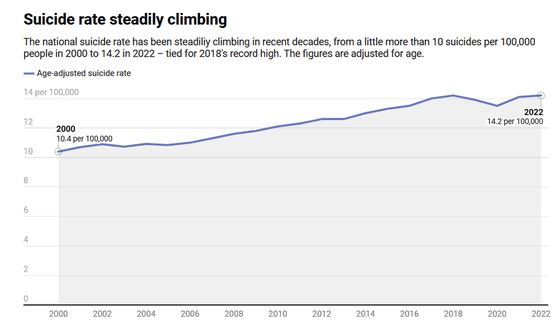Why are teachers and librarians less likely to commit suicide?

Suicide rates among working-age people vary greatly by occupation. A 2021
Teachers and librarians are among those least likely to die by suicide − public health researchers offer insights on what this means for other professions
https://theconversation.com/teachers-and-librarians-are-among-those-least-likely-to-die-by-suicide-public-health-researchers-offer-insights-on-what-this-means-for-other-professions-252795

Below is the trend in suicide rates as shown in the 2024 National Strategy for Suicide Prevention published by the US Department of Health and Human Services. The graph shows the number of suicides per 100,000 working-age people in the US, which has increased significantly over the past 20 years, from 10.4 per 100,000 in 2000 to 14.2 in 2022.

The suicide rate in the United States in 2022 varies greatly by gender, with 23 suicides per 100,000 men compared to 5.9 per 100,000 women. It has also been found that people in certain occupations are at higher risk of suicide than others.
There are various reasons why suicide rates vary by occupation, including exposure to tasks that negatively affect mental health, low job stability, and the demographics of the occupation. For example, military personnel are more likely to have a low fear of death, a high tolerance for pain, and are more likely to have a disrupted daily rhythm and struggle to transition to normal civilian life, which is thought to increase suicide rates.
Why do military personnel have such high suicide rates?

On the other hand, the occupation of 'education workers,' classified by the Bureau of Labor Statistics as 'educational instruction and libraries,' has been reported to have a lower suicide rate overall. According to Batchelor, when public health researchers look at suicide data, they often focus on high-risk populations to see where intervention and prevention are most needed. However, the analysis is important because there are things to learn from low-risk populations as well.
The reason for the statistically low suicide rate among education workers is, first of all, the significantly higher proportion of women among education workers overall. Because suicide rates are significantly lower among women than men, occupations with a higher proportion of women in the demographic composition tend to have lower suicide rates. In addition, people in teaching jobs tend to be highly educated, and researchers point out that a higher education level increases socio-economic status and employability, which may help prevent suicide.
Another notable factor associated with higher suicide rates is 'access to lethal means.' A 2017 study showed that workplaces with easy access to lethal means, such as medicines and firearms, such as medical workers and the military, are closely associated with suicide rates. Meanwhile, the relatively low availability of lethal means in schools may be keeping suicide rates low among education workers.
Guns increase suicide rates - GIGAZINE

by ZH
In addition, work environments such as schools and campuses are thought to be good for mental health because they provide plenty of opportunities to build strong social relationships. Furthermore, education workers tend to lead healthier lifestyles, with fewer people having alcohol or drug problems compared to other workers, which may also reduce the risk of suicide.
Batchelor explains the results of the analysis, 'The lesson learned from analyzing education workers with low suicide rates is that they need to develop skills to cope with work stress. Identifying the root causes of work stress and utilizing coping skills such as positive thinking, meditation, and goal setting can have beneficial effects. Building social networks in the workplace is also important. Social networks can provide tangible and intangible support and help establish a sense of purpose and identity. The idea that environmental factors are suppressing suicide rates in education workers means that workplaces and organizations can foster a positive culture.' In addition, Batchelor says, 'The importance of continued research on occupational health is noteworthy. Although no one is immune to suicide risk, all suicides are preventable.' He emphasizes the importance of further research.
Related Posts:
in Note, Posted by log1e_dh





